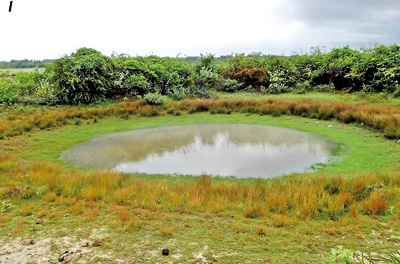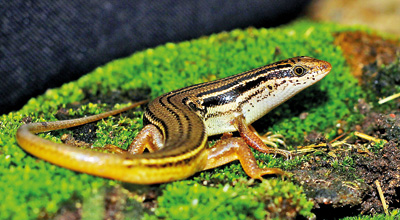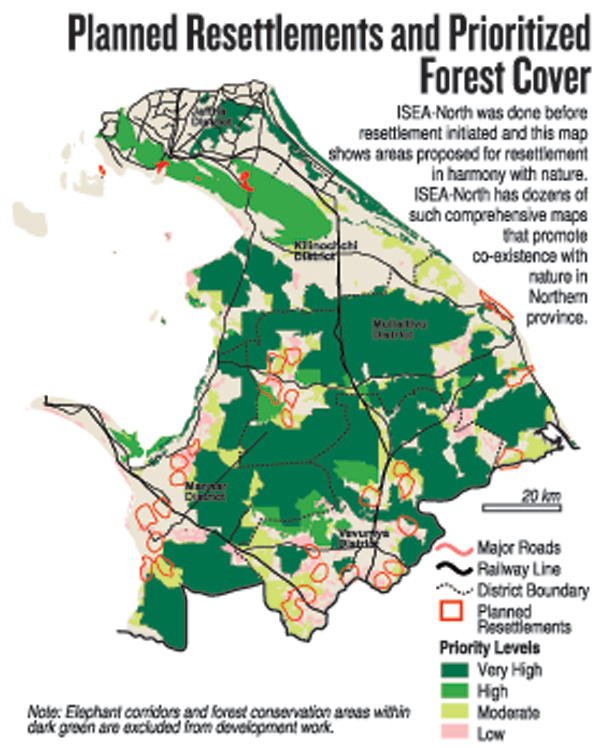News
Team hunted down hidden quarry in Jaffna’s rugged terrain
Remnants of war were still evident in 2014 when this team launched its search operation in the Jaffna peninsula. Members combed the territory, checking muddy marshes, waterholes, beaches, thorny scrub jungles and abandoned facilities; they moved carefully across the rugged landscape, turning rocks, lifting decaying logs and even fallen palm leaves in their path.

Bombed out pits-turned freshwater pools have become home to Uda Handya fish (Killifish). Pic Sameera Karunarathna
They conducted the operation both in daytime and by stealth at night, maintaining silence and listening for movements and sounds from those disturbed by their presence. They chased down those trying to flee.
This team was, however, not a search party looking for caches of weapons or landmines but a group of herpetologists studying the reptiles and amphibians in the Jaffna peninsula.
Altogether, 44 species of reptiles and 15 species of amphibians were found, including 18 that had not previously been reported from Jaffna. The documented tally of the peninsula’s reptiles and amphibians now stand at 85 species.
The findings of the team, consisting of Majintha Madawala, Thilina Surasinghe, Dinesh Gabadage, Madhava Botejue, Indika Peabotuwage, Dushantha Kandambi, Sameera Karunaratna and well-known herpetologist Dr. Anslem de Silva, were published this week in the Russian Journal of Herpetology.
The team had some pleasant surprises. “Soon after we landed from the boat on Delft island and had just started turning over fallen palm leaves we found 15 saw-scaled vipers, known as weli polanga in Sinhala.
“They are all venomous snakes, but it was a happy start for herpetologists like us,” study author Sameera Karunaratna said.
The last battles of the three-decade-long war took place at Nandikadal Lagoon and that is where the research team found the rare Beddome’s striped skink (Eutropis beddomei), a beautiful red skink that moves rapidly. 
“It is so fast and makes sudden moves to elude pursuers so you’d need at least a team of 10 people to catch one,” said Mr. Karunaratna, laughing. “The good news is that there is a healthy population of this skink.”
Among other special findings, the research team found a green whip snake (ahatulla) which is not common in this area.
Mr. Karunaratna said there is considerable urban biodiversity in Jaffna. “We found soft-shelled terrapins and hard-shelled terrapins in the drainage of Jaffna town itself,” he said. “We also found some empty shells that indicate they would have been targeted for meat.”
He said the team’s field survey was based on four field visits covering 12 days, so the area covered was small.
“The fact that we managed to find this many reptiles indicates that Jaffna and northern Sri Lanka could harbour even more reptile species,” Mr. Karunaratna said.
“Our study will provide a basic foundation for conservation planning and future research,” he said.

Eutropis-beddomei (Beddome's stripe skink) found in Nandikadal
| Fish find home in artillery holes | |
| Huge pits created by artillery explosions that pockmark the landscape of the peninsula show the intensity of the bloody war fought in the north – but many of these pits are now nurturing colourful life. The pits, which range from 15m in diameter to several perches in extent, become artificial pools when filled with rain, herpetologist Sameera Karunaratna said. “We found varieties of killifish species known as ‘uda handaya’ in these earth depressions that act as artificial pools now,” Mr. Karunaratna said. “There are dozens of them in the area and in drier periods the shallow areas dry out but water remains in the deeper sections, giving a lifeline to the fish.” Killifish are small creatures that are short-lived and lay eggs. Some lay their eggs where floating plants grow while others bury them in the sand of the pools they inhabit. When the pools dry up the fish die but when rains return and the pools fill up, the eggs hatch and life begins again. |

| Science should guide the peninsula’s growth plans | |
| With the new government in power, many expect a fresh wave of development in the Jaffna region but experts are urging that this does not follow the previous pattern of ignoring environmental concerns. Development became the priority for northern Sri Lanka area when the civil war ended in 2009. In order to prevent initiatives backfiring over lack of environmental planning, the Central Environment Authority (CEA), in collaboration with the Disaster Management Centre and the United Nations Development Programme, carried out an “Integrated Strategic Environment Assessment for the Northern Province” (ISEA-North), with work beginning in 2009 itself, prior to the resettlement of people displaced by the war. Its purpose was to accelerate economic growth by identifying freely available land and resources for development while providing a framework to protect environmentally and culturally sensitive areas. Information gathered from stakeholder agencies allowed researchers to identify sensitive and disaster-prone areas where development should be restricted or managed. Further, the study identified more than 200 new archeological sites. Areas suitable for development activities such as industry, agriculture, ecotourism and other ventures were identified and mapped, with the most sensitive forests, wildlife, marine, coastal and archaeological areas excluded. After completion in 2012, the plan was reviewed in 2014. The Sunday Times learns that some aspects of this comprehensive strategic plan have been largely disregarded. Analysts said wasting this effort was a pity, pointing out that overseas observers had specially visited Sri Lanka to learn from the ISEA-North process and UN has recognised the participatory scientific approach as a model for rebuilding in crisis/conflict situations. The report can be downloaded from the CEA website, cea.lk. |

